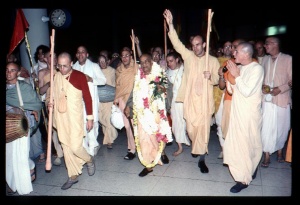SB 4.9.2

A.C. Bhaktivedanta Swami Prabhupada
TEXT 2
- sa vai dhiyā yoga-vipāka-tīvrayā
- hṛt-padma-kośe sphuritaṁ taḍit-prabham
- tirohitaṁ sahasaivopalakṣya
- bahiḥ-sthitaṁ tad-avasthaṁ dadarśa
SYNONYMS
saḥ — Dhruva Mahārāja; vai — also; dhiyā — by meditation; yoga-vipāka-tīvrayā — on account of mature realization of the yogic process; hṛt — the heart; padma-kośe — on the lotus of; sphuritam — manifested; taḍit-prabham — brilliant like lightning; tirohitam — having disappeared; sahasā — all of a sudden; eva — also; upalakṣya — by observing; bahiḥ-sthitam — externally situated; tat-avastham — in the same posture; dadarśa — was able to see.
TRANSLATION
The form of the Lord, which was brilliant like lightning and in which Dhruva Mahārāja, in his mature yogic process, was fully absorbed in meditation, all of a sudden disappeared. Thus Dhruva was perturbed, and his meditation broke. But as soon as he opened his eyes he saw the Supreme Personality of Godhead personally present, just as he had been seeing the Lord in his heart.
PURPORT
Because of his mature position in yogic meditation, Dhruva Mahārāja was constantly observing the form of the Personality of Godhead within his heart, but all of a sudden, when the Supreme Personality disappeared from his heart, he thought that he had lost Him. Dhruva Mahārāja was perturbed, but upon opening his eyes and breaking his meditation he saw the same form of the Lord before him. In the Brahma-saṁhitā (BS 5.38) it is said, premāñjana-cchurita-bhakti-vilocanena: a saintly person who has developed love of Godhead by devotional service always sees the Lord's transcendental form of Śyāmasundara. This Śyāmasundara form of the Lord within the heart of a devotee is not imaginary. When a devotee becomes mature in his prosecution of devotional service, he sees face to face the same Śyāmasundara he has thought of during the entire course of his devotional service. Since the Supreme Lord is absolute, the form within the heart of a devotee, the form in the temple and the original form in Vaikuṇṭha, Vṛndāvana-dhāma, are all the same; they are nondifferent from one another.